The federal battery rebate isn’t just for new home battery systems: it can also be used to expand existing batteries. Here’s how to do it.
As home batteries finally become mainstream thanks to the 30% discount offered by the Cheaper Home Batteries Program, early adopters who took the plunge back when batteries were smaller and more expensive might feel shortchanged.
They’d be wrong: the rebate also applies to the expansion of existing batteries, whether that’s adding batteries in parallel or additional stacks for a modular battery system.
Battery Rebate Rules On Expanding Batteries
Existing batteries can be expanded provided that:
- The battery system has not already received the rebate;
- The additional capacity is at least 5 kWh;
- The upgraded battery does not exceed 100 kWh in nominal capacity.
There are also rules specific to modular batteries which feature stackable or connectable units, allowing owners to start with the basics and add stacks of additional capacity as needed. Added stacks are eligible provided:
- The entire stackable battery system is on the CEC’s approved product list at the date of certification – if the battery management module or another component isn’t on the list, then the system is ineligible;
- The installer re-certifies the entire system, including the connection to the electrical installation, as safe, compliant and meeting all requirements, identifying and upgrading any parts of the existing system as required.
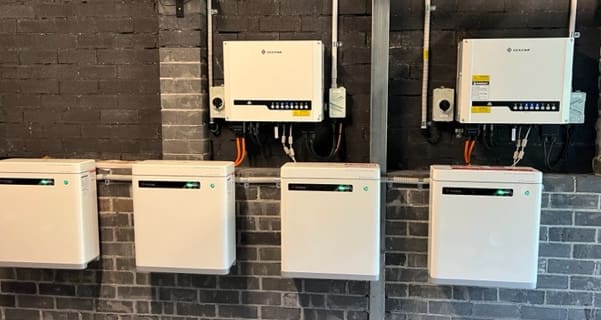
GoodWe hybrid inverters with 4 battery modules.
Early Adopters Might Have Obsolete Gear
If you’re an early adopter, you’ve likely got a modest system that could use more storage capacity, (kilowatt-hours) or more outright grunt (kilowatts-peak) to run more appliances.
Ten years ago, back when grid interactive systems were the latest technology and Elon was still cool, the tech savvy in your neighbourhood were installing High Voltage DC batteries like Tesla Powerwall 1, BYD or LG Chem. These needed a separate SolarEdge, Fronius or SMA inverter.
Meanwhile Sungrow, Victron and Solax were supplying inverters for Low Voltage batteries, using the plethora of available technologies, like nickel-iron, zinc-bromide, but more often lead-acid and various lithium chemistries offered in a traditional 48 volt package.
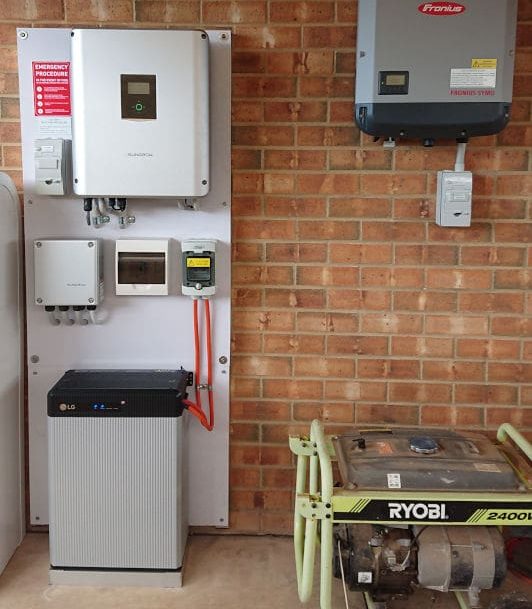
Older Sungrow 5kW hybrid with LGChem 48V battery. This setup would need a parallel connection box if you were to add a second battery. Fronius adds some 3 phase grunt when the grid is present.
And Enphase were doing their own tiny cute things too.
However, early systems were all pretty dinky, and are now for the most part obsolete, unless you chose the incomparable Selectronic SpPro, which is a remote area system with a side hustle doing grid-connected backup.
Older brands and obsolete models may struggle on the secondhand market, so you’ll need to decide: are you seeking out niche collectables or starting again?
Even the Tesla Powerwall 2, which was enormously successful, has been discontinued, and isn’t even compatible for Powerwall 3.
To stick with an older model, bear in mind that you’ll need an electrician willing to at least connect secondhand equipment, and in some instances extra hardware to parallel connect batteries.
If there’s compatibility or integration problems, you may need to be savvy with your own tech support. Paying qualified trades for problem solving could very quickly blow your budget otherwise.
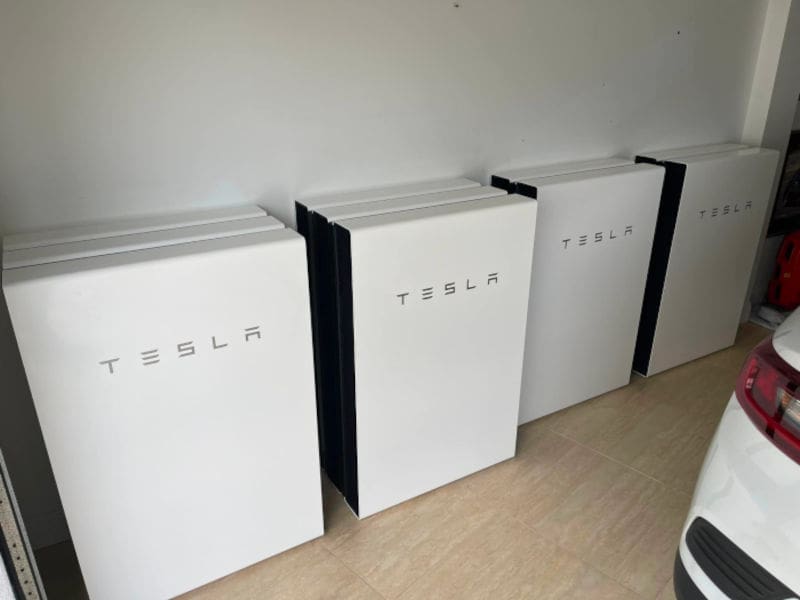
Some people collect Teslas. Image credit: Skyline Solar
Newer Equipment Is Easier To Upgrade
For those with current generation hybrids like SolarEdge, Sungrow, GoodWe, Fronius/BYD then adding more of the same battery makes good sense. Bear in mind though, depending on the model, your new battery may only perform as well as the legacy unit. The battery management software will manage the whole system down to the capacity of the oldest cell block.
We’re told the latest models of AC-coupled Enphase batteries can be derated to 1.65kW peak, so with 10kW of connection approval, you can have 6 units for 30kWh of storage capacity.
Be Aware
Many networks in Australia rely on Clean Energy Council (CEC) certification for their connection approval process.
If you’re after a used battery, getting network permission may be difficult if the CEC approval has expired.
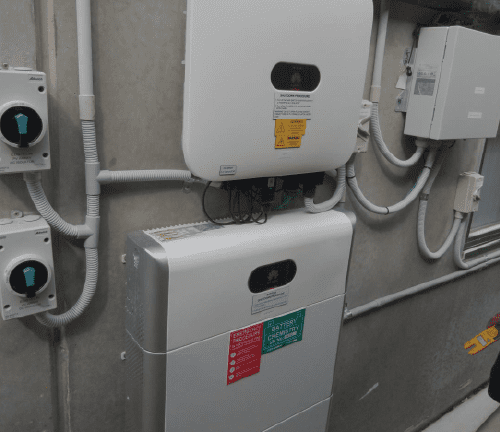
Huawei inverters may now be obsolete in Australia, however iStore are made in the same factory so there could be some support available locally.
Battery Brands Don’t Play Well With Each Other
Mixing brands of battery systems may also prove impossible; batteries will waste energy fighting each other unless you can manage a clever third-party integration.
The other option is to keep them separated by wiring to different sub-boards, a workaround that requires diversity in loads and thinking.
A benefit of splitting up different systems to back up different loads on different circuits does offer more redundancy, so a modest inverter won’t for instance, be overwhelmed by the fridge and freezer both starting at once.
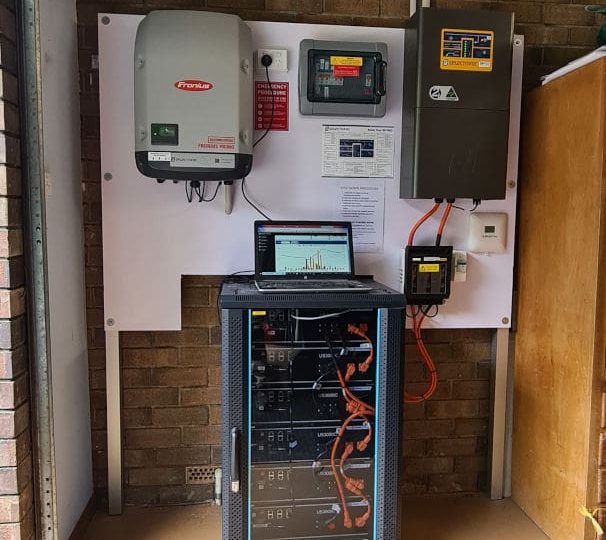
6 pylontech 48 Volt batteries powering a Selectronic SpPro with Fronius solar inverter. This sort of setup is bulletproof, expandable and doesn’t need any internet.
You Can Add Most Anything
All inverters must comply with the grid connection standard of AS4777, so if you have existing solar, it can be AC coupled to a new battery or hybrid inverter.
Where things get tricky is getting connection approval from your network. When adding equipment the poles and wires people must know what’s going on, but with 17 different DNSPs across Australia it’s difficult to track all the rules.
Generally you can have 10kW of inverter capacity per phase. For some that’s an absolute ceiling, so the classic combo of 5kW Enphase microinverters with 5kW Powerwall 2 means nothing more will fit.
Others allow 10kW of solar generation plus an additional 10kW of battery inverter. However a hybrid machine will count toward both totals and even if you have 3 phase, there is still a 30kVa ceiling for the whole site.
The local network may allow more capacity, but may need a significant fee paid for an investigation, and there could be an export limit imposed.
Array Wiring May Not Pass Muster
The solar installation standard of AS/NZS 5033 was updated in 2014, at which point all DC wiring had to be run in conduit for mechanical protection, and panels had to be fire-rated. Most electricians will be uncomfortable trying to reuse these arrays, which are pretty ancient by solar industry standards.
The specifications changed again in 2021 to align with international standards, so even fairly recent solar installations may be deemed obsolete, especially if it’s cheap gear that’s badly installed. A conservative company may want nothing to do with an existing array on their new compliance certificate.
However, if you bought high-quality solar panels, which are well installed, I wouldn’t be shy about keeping them going. There’s no point tearing down and grinding up functional electrical equipment.
Provided they pass electrical testing, changing the terminals to suit a new inverter is a minor repair to what was a compliant installation.
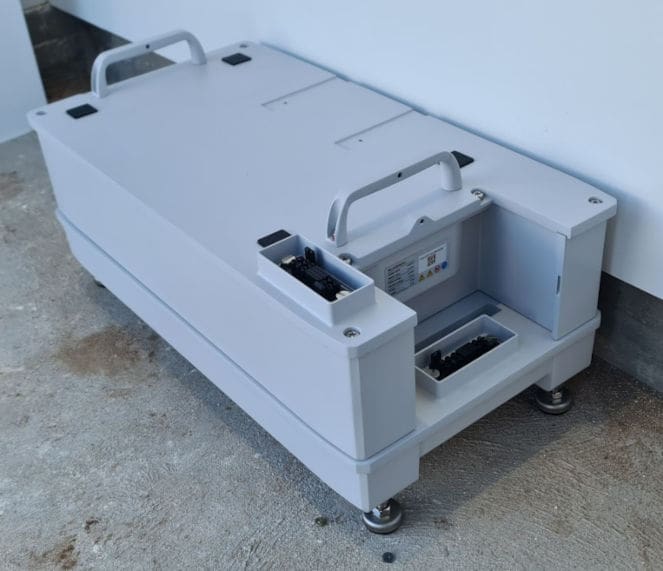
Sungrow base plate and a single 3.2kWh cell block ready to accept two more blocks.
Rules Are Subject To Change
If you’re thinking about expanding an existing battery my advice is to get on with it before the goalposts move.
When the federal rebate was initially released, expanding a stack wasn’t eligible for subsidy. The only way to get additional capacity was to buy a complete battery stack and connect it in parallel. Thankfully that problem has been solved.
However a new Australian technical specification is in the works. We’ve seen an exposure draft and the industry is pushing to have it reworded. As it stands, there’s some risk that an estimated 80% of the current batteries on the market could soon be technically non-compliant.
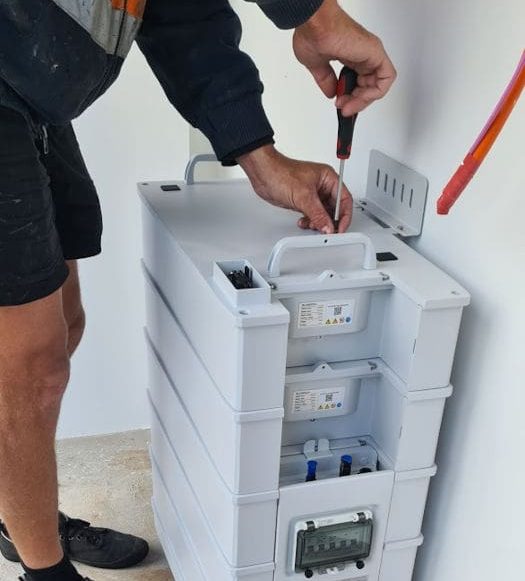
5 Sungrow cell blocks ready for a lid on a 16kWh stack.
Full Replacement May Still Be The Best Option
As an electrician I was often caught between customer expectations and electrical reality. When salespeople glossed over or punters over estimated, I was left to rationalise backup ability over a limited number of circuits.
It’s not just the cheap stuff that would disappoint. Those with a 3 phase hybrid would find their 5kW inverter capacity (divided by 3 phases) was only 7½ amps.
For comparison, a 5kW machine that concentrates all its effort on a single phase offers a potential 26 amps of surge capacity, so they’re much more capable.
These days inverters are designed for “whole home” backup, with enough peak capacity they might even run your ducted air conditioner during an outage, however that kind of consumption monster will likely need a behemoth battery.
This is where it is critical to get your expectations for the system aligned with the technical capacity, economic reality and the sales delivery.
Write down what you’d like ideally, what you might need and what’s essential during a blackout, then get the solar supplier to sign off on what they promise will do the job.
For more, read our guide on how modular batteries work, and read our guide on everything you need to know on battery prices, paybacks and brands.

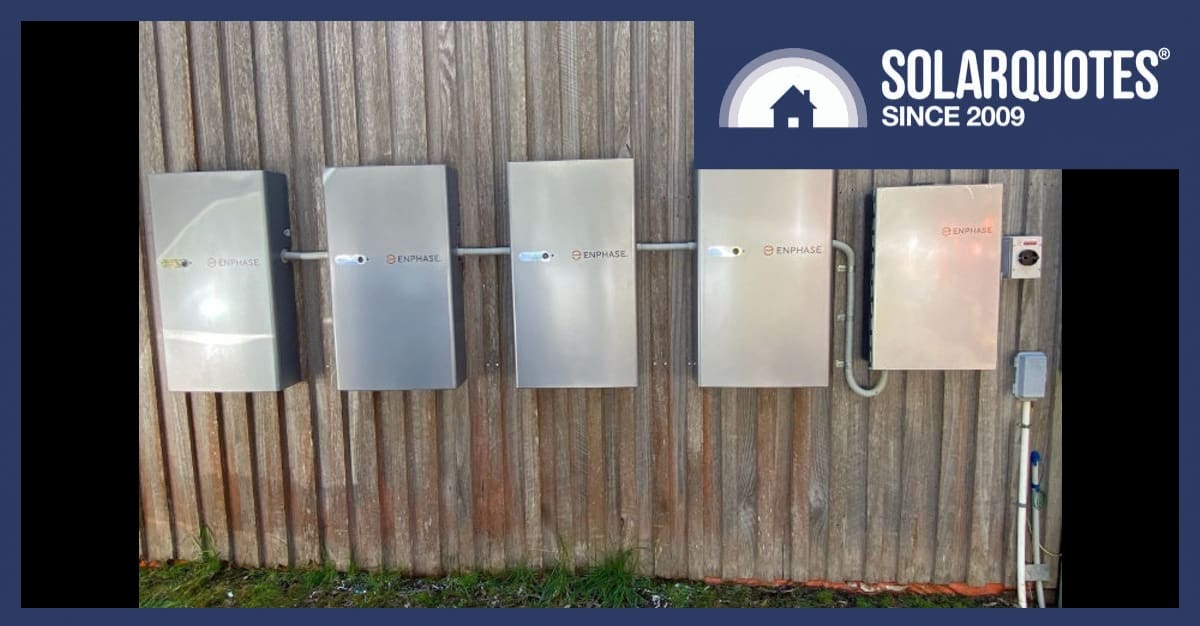
 RSS - Posts
RSS - Posts


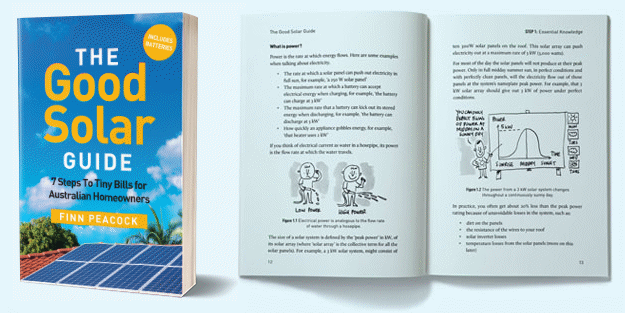
I have a 11.78kW solar system and Powerwall 2. I’ve sliced and diced the permutations but couldn’t find a way for a second battery to make sense. In winter, the only time when the existing solar + battery really requires grid supplementation, there’s not enough solar production some days to fill even one PW2. I can use cheaper grid rates but even then I doubt I’d fill two PW2s with them in the time allowed, as well as charge an EV overnight.
Plus I spend about $300-$400 over winter buying grid power to supplement the system, and after 10 years that will still be only 30-40% of the outlay needed to add an additional PW2.
Am I missing anything obvious?
Hi Nick,
The sums don’t always add up for more battery like they do for more solar, so it’s not just you. Many just want more on general principle, especially if they’ve experienced long outages or have grand designs on energy trading.
I looked at energy trading too, the time-series data for wholesale pricing, and the gain was pretty marginal over the longer term, and I’m guessing will get even more marginal as more renewables and batteries enter the system.
Hello again Anthony. Can you clarify something for me. I recently went to a installer to add a bettery to my system, i have 1 Apower battery and was just about to go ahead, when i found out that the Franklin Apower2 is eventually coming to Astrailia. So i put on hold this addition. But now the installer says that the Gov Rebate Funds will rum out because of massive uptake before 2030. He estimated that the funds will run out in a couple of years. Can you comfirm or deny this. Regards Hans
Hi Anthony, To my knowledge i have never read about the Franklin WH on Solat Quotes. This Battery is always in the top best 3 or 5 in the US. It came on the market in Australia in July 2023. It was called just the Apower FranklinWH. 13.6KW. There is now an APower2 with 15KW available for the American Market. Have you any idea when this APower2 will come on the Australian market. As i was going to take advantage of the GOV Rebate to add to the onre i have, however i may have to wait till the APower2 comes into Australia. Regards Hans
Hi Hans,
I’ve looked over the Franklin device at the recent Smart Energy conference Adelaide. Should do an article shortly.
It’s much like a Tesla PW3 in terms of being seppo centric, and as such probably doesn’t suit 3 phase properties as well, but not a bad piece of kit.
I am one of those with an existing system and weighing up adding a now discontinued Powerwall 2 battery or selling them and starting over at some loss.
I understood that the rebate could only be applied to new batteries being added to existing systems, that used batteries (even installed professionally, etc) would not be able to attract the rebate. Is that not correct?
I am thinking about it. But i upgraded to 19.2kWh from 12.8 just before the subsidy came in, so i want to see how i go with that over summer before making a decision if i add another 19.2kWh stack.
I certainly dont use that much power overnight in winter (being in Qld), rarely getting below 50% on the 19.2kWh battery over winter, and it is full again by 11am. So it doesnt matter whether i can charge a bigger battery in winter, but the air cons get a fair flogging in summer, when i do generate enough solar to feed 38kWh of batteries.
So probably around December / January I will make the call on upgrading depending on how low that 19/2kWh battery is getting overnight.
Hi guys, is 20kw of solar panels enough to charge a 24 kwt battery in the winter time on the Central Coast of NSW?
Assuming 10kW inverter and no shading from sunrise to sunset then my guess would be yes 50% of the time….
As long as you had sun for 2.4 hours or partly cloudy for 5 hours. Full rain day with thick clouds probably get around halfway there…
But with 24kW storage you’re also unlikely to start day with a flat battery either huh
I have just added a second Powerwall 2 to my existing one that was new in 2022. The 2022 one was a replacement for my original Powerwall which started smoking.
The addition didn’t activate with my original Gateway, which Tesla agreed to replace with the latest model.
After rebate the installed cost was $10,000. The replaced Gateway was zero.
I decided on the addition due to grid failures we sometimes get in Summer. Now I can sell the emergency Honda generator. With 2 Powerwalls we can use a small inverter split air conditioner for many hours.
Our batteries completely fill on days when 4 to 5 hours of sun occurs. We have 8.8kw of panels.
Our Adelaide supplier/installer had quite a few new Powerwall 2 models in stock.
Hi all,,
Very interesting AB but still leaves my system querying the bit about Enphase.
I have 3 5P batteries which, on whole consumption configuration, are filled by 9am and depleted to 30% by 7pm at which point I am switched to drinking from the grid. Should I add another “tiny” enphase? or wait for another larger battery? Maybe someone with a similar battery setup can advise?
Best Regards and thanks for the article,
Matt
Hi Matt,
Enphase are small and expensive sadly. In better news I’m told they will now configure and commission the 5kWh batteries as a nominal 1.65kW inverter capacity, meaning the DNSP will allow more of them to be connected.
For instance, in SAPN land you can have 10kW/phase for genreation and 10kW/phase for battery inverters.
As I understand it you could have 6 units with 1.65kW inverters offering 9.9kW of “battery capacity” for connection approval purposes, but by Enphase standards a huge 30kWh rated storage.
Depending on your connection (single or three phase) you may be able to AC couple your Enphase gear to a hybrid inverter or even a Franklin AC coupled battery?
Set up the 3 x 5p units to do one part of the house and another hybrid inverter to cover the rest?
Thanks AB,
I’ll try to contact the installer with your possibilities and see what he is willing to do!
Maybe wait to see if a mortgage on a second-hand Atto 3 would pay in the long run,
Regards
Matt
Hi. I’m waiting on Tesla Powerwall3 expansion unit to be certified by the Clean Energy Council. This is the same as the standard Powerwall3 but without the inverters. Have you heard anything about when this expansion unit will be certified or as it’s essentially the same as the current certified powerwall3 that it won’t need specific certification?